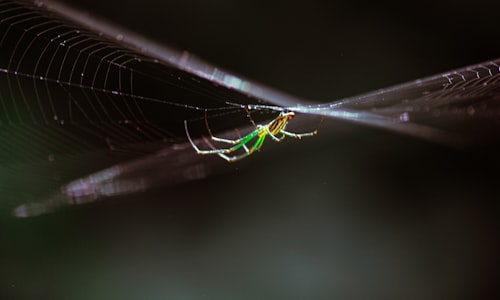Spiders Webs facts
While investigating facts about Spiders Webs, I found out little known, but curios details like:
Even though daddy-long-leg spiders don't have powerful enough venom to harm humans, they hunt and kill larger spiders that can kill humans, like the redback spider. They use their long legs to quickly wrap other spiders with webbing, immobilizing them before biting and eating them.
A mother black lace-weaver spider will drum on her web to call her babies to come and eat her alive.
In my opinion, it is useful to put together a list of the most interesting details from trusted sources that I've come across. Here are 50 of the best facts about Spiders Webs I managed to collect.
-
Mazda had to recall 52k cars due to a species of spider loving the smell of gasoline so much it chose to build its web in the cars emission systems.
-
When spiders ingest nanotubes, they weave silk reinforced with carbon. The spiders can make webs capable of holding humans.
-
The Scythian Philosopher Anacharsis "Laws are spider-webs, which catch the little flies, but cannot hold the big ones."
-
Australian Funnel-Web spider fangs can penetrate fingernails and shoes
-
In 1973 NASA sent two spiders known as Arabella and Anita into space to see if the could spin a web without gravity. It took the spiders a couple days to figure out, but they eventually ended up making webs that were finer and more complex than their earth counterparts.
-
It is common for spiders to eat their own web daily to reuse the silk proteins.
-
Despite being no larger than 4cm, the female Darwin's Bark Spider can create a web bridge spanning up to 75 feet across rivers by releasing several strands of silk which the wind carries to the other side. She then reinforces it, allowing her to hunt for insects flying over the river.
-
The funnel-web spiders venom is extremely toxic to primates, but mostly harmless to many other animals. There are no primates in Australia, apart from humans.
-
There is a spider that builds larger fake spiders and hangs them in its web
-
There is a tiny spider that builds large, fake spiders in their web out of debris to serve as decoys.

What is true about spiders webs?
You can easily fact check it by examining the linked well-known sources.
107 million spiders invaded a factory and covered every surface with heavy sheets of web.
Spiders are often Omniverous, using their web to catch pollen, which can make up 25% of their diet. - source
Spiders can be affected by different drugs, like marijuana and LSD, which shows in their web-making. This phenomenon has been studied by NASA. - source
The last time someone was killed by a spider in australia was in 2016, the second last time was in 1979, a total of 37 years. this was due to an anti-venom being made in 1980 for funnel web spiders.
Many orb-weaving spiders, including the common Barn Spider, take their webs down every day and build another web every evening, eating the old webs to reclaim resources. This is why most orb-shaped spider webs are free of debris and always look new - source
A community of monks in the Austrian Alps in the 16th century invented a method of painting on canvas made from spider webs, and today less than 100 known examples exist.
Just a single pound of spider web could form a single strand long enough to stretch around the equator
Spiders can get high and build different webs on weed, caffeine, mescaline and LSD
In order to try an avoid being eaten by its mate, the male orb-web spider has detachable genitals that keep pumping after it's run away.
There is a spider web farm in Vermont where cells are hung so orb weaving spiders will make webs which are later sprayed white and added to frames for preservation. More than 16,000 have been collected since the 1970s.